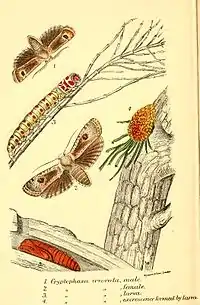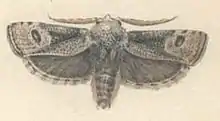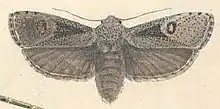Cryptophasa irrorata
Cryptophasa irrorata is a moth in the family Xyloryctidae. It was described by John Lewin in 1805. It is found in Papua New Guinea and Australia,[1] where it has been recorded from the Australian Capital Territory, New South Wales, Queensland and South Australia.

| Cryptophasa irrorata | |
|---|---|
 | |
| Male | |
 | |
| Female | |
| Scientific classification | |
| Kingdom: | |
| Phylum: | |
| Class: | |
| Order: | |
| Family: | |
| Genus: | |
| Species: | C. irrorata |
| Binomial name | |
| Cryptophasa irrorata Lewin, 1805 | |
The wingspan is 43–58 mm. The forewings are grey, more or less sprinkled with ferruginous and brown, and coarsely irrorated (sprinkled) with black and with a small darker spot in the disc before the middle, and a second beneath the first. There is an obscure pale dark-margined reniform spot in the disc at two-thirds, connected with the costa beyond the middle by an indistinct streak. There is a row of more or less marked dark fuscous spots along the hind margin and posterior half of the costa. The hindwings are rather dark fuscous.[2]
The larvae feed on Casuarina species. They bore in the stem of their host plant, tying cut branchlets at the entrance to the bore.[3]
References
- Savela, Markku (25 April 2016). "Cryptophasa irrorata Lewin, 1805". Lepidoptera and Some Other Life Forms. Retrieved 5 July 2020.
- "Redescription of Cryptophasa irrorata Lewin, 1805 (Lepidoptera: Gelechioidea: Xyloryctidae)"
- "Cryptophasa irrorata". 15 September 2010. Xyloryctine Moths of Australia. Retrieved 5 July 2020.